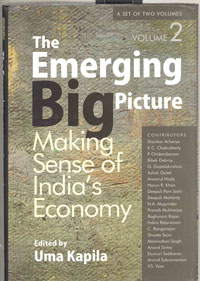
Mixed thoughts on Indian growth
Asjadul Kibria | Friday, 12 February 2016

Tracking the growth dynamics of a big economy is a difficult task. Nevertheless, dedicated scholars go ahead with such exercise in various forms. Dr Uma Kapila is such a dedicated one. She has been tracking and analysing India's development journey for last four decades. The outcome of her work is a series of books, written and edited in various capacities. She taught economics in Delhi School of Economics and Delhi University for 42 years. She wrote and edited text and reference books on Indian economy for undergraduate students.
A recent notable work of Dr Kapila is editing two volumes of books that soutline the next phase of Indian economy. The Emerging Big Picture: Making Sense of India's Economy is basically a compilation of essays and articles written by 21 top policymakers, eminent economists and experts. A total of 60 articles are compiled in two volumes - 35 articles in the first volume focus on macroeconomic challenges and real sectors while the rest 25 articles in the second volume focus on the financial sector.
The idea behind editing and publishing the book is to summarise the thoughts and guidance of policymakers and economists on accelerating India's economic growth. The recent slowdown in growth momentum when a rate of double-digit growth was very close has become a concern for the country's policymakers, businessmen and economists.
The book observes: "India clocked an average growth of 9.5 per cent in the three-year period (2005-2008) before the global financial crisis. This remarkable growth performance was certainly a cause of celebration. It was also, according to Dr Subbarao, a trigger for setting off an aspiration for double-digit growth...However, the growth rate slowed to 6.2 per cent in 2011-12 and the slowdown continued in 2012-13 when it registered 5 per cent growth....This downturn has caused widespread anxiety that we may not have derailed from the high growth trajectory. It has also raised a number of questions. Is our growth story faltering? Has India's potential growth rate declined? Are the growth drivers that worked our way during 2003-2008 still intact? Has the world lost confidence in Indian's growth promise? When will we reach double-digit growth and what indeed should we be doing to get there?" (P-19) The book tries to find out answers of these major questions.
A generalised answer, derived from the writings of many of the writers, is: "India's poor infrastructure, excessive regulation, small manufacturing sector and a workforce with inadequate education and skills and lack of governance" (P-20) are major hindrances to higher growth.
At the same time, some argue that India achieved higher growth (above 8.0 per cent) when many of these hindrances were there. The writers have presented their thoughts through such analyses and counter-arguments.
A good number of articles provide theoretical analyses with real world data. These are helpful for further research. For instance, C Rangarajan's 'Dynamics of Inflation' concludes: "However, the primacy of price stability as an objective of monetary policy particularly in developing economies must be recognised." (P-176) Again, a few articles have relevance beyond border. For instance, K C Chakrabarty's article titled 'Frauds in the Banking Sector: Causes, Concerns and Cures' describes and analyses different aspects of fraudulent activities in the Indian banking sector. The pattern of analysis is also relevant for Bangladesh and other countries in South Asia.
However, almost all the articles in the book are actually reprint or republished as these were earlier presented as speeches, lectures and papers on different occasions and published in different newspapers and bulletins. Thus some of the articles or parts of these have become less relevant with time.
The list of the writers reflects the depth of the collection. President Pranab Mukherjee, former Prime Minister Manmohan Singh, former finance minister P Chidambaram, former governor of the Reserve Bank of India (RBI) Duvuri Subbarao and current RBI governor Raghuram Rajan are the top policymakers whose articles are there. Again, eminent economists like Bibek Debroy and trade experts like Anwarul Hoda have also contributed articles.
There is a common joke about the economists. It says: 'Q: What does an economist do? A: A Lot in the short run which amounts to nothing in the long run.' While perusing the voluminous book, one may find the joke true to some extent. Nevertheless, the collection is a good resource to develop better understanding on the Indian economy.
asjadulk@gmail.com
.............................
The Emerging Big Picture: Making Sense of India's Economy
Edited by Dr. Uma Kapila
Academic Foundation, New Delhi. 2014 Pages: 415 +368 (A set of 2 volume)